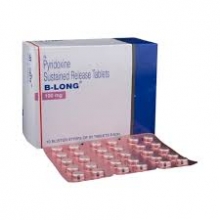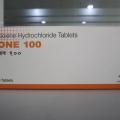Home / Categories / B-LONG-100MG

B-LONG-100MG
(30)
PYRIDOXINE(B6)-100MG
VITAMIN AND MINERALS
TORRENT PHARMACEUTICAL
Product Details
| Pyridoxine HCl (B6) |
| (peer-ih-DOX-een HIGH-droe-KLOR-ide) |
Aminoxin, Nestrex,  Hexa-Betalin Hexa-Betalin |
| Class: Vitamin |
 Action Vitamin B6 functions as coenzyme in amino acid, carbohydrate and lipid metabolism.
Action Vitamin B6 functions as coenzyme in amino acid, carbohydrate and lipid metabolism.
 Indications Pyridoxine deficiency, including inadequate diet, drug-induced causes (eg, isoniazid, hydralazine, oral contraceptives) or inborn errors of metabolism. Parenteral use is indicated when oral therapy is not feasible. Unlabeled use(s): Treatment of hydrazine poisoning, PMS, hyperoxaluria type I, nausea and vomiting in pregnancy, sideroblastic anemia associated with high serum iron, carpal tunnel syndrome, tardive dyskinesia.
Indications Pyridoxine deficiency, including inadequate diet, drug-induced causes (eg, isoniazid, hydralazine, oral contraceptives) or inborn errors of metabolism. Parenteral use is indicated when oral therapy is not feasible. Unlabeled use(s): Treatment of hydrazine poisoning, PMS, hyperoxaluria type I, nausea and vomiting in pregnancy, sideroblastic anemia associated with high serum iron, carpal tunnel syndrome, tardive dyskinesia.
 Contraindications Standard considerations.
Contraindications Standard considerations.
Dietary Deficiency
ADULTS: PO/IM/IV 10 to 20 mg/day for 3 wk.
Drug-Induced Deficiency Anemia or Neuritis
ADULTS: PO/IM/IV 100 to 200 mg/day for 3 wk; follow with 25 to 100 mg/day.
Neuropathy
ADULTS: PO/IM/IV 50 to 200 mg/day.
Vitamin B6 Dependency Syndrome
ADULTS: PO/IM/IV 600 mg, followed by 30 mg/day for life. Dependency has been noted in adults administered 200 mg/day. PYRIDOXINE-DEPENDENT INFANTS: IM/IV 10 to 100 mg, followed by 2 to 100 mg/day.
Metabolic Disorders
ADULTS: PO/IM/IV 100 to 500 mg/day.
Isoniazid (INH) Poisoning
ADULTS & CHILDREN: IV 4 gm IV followed by 1 gm IM q 30 min until pyridoxine dose equal to INH dose has been given.
Cycloserine, INH, hydralazine, oral contraceptives, penicillamine: Increased need for pyridoxine. Levodopa: Decreased effect of levodopa. (Interaction does not occur with levodopa/carbidopa in combination with pyridoxine.) Phenytoin: Phenytoin serum levels may be decreased. Parenteral: INCOMPATIBILITIES: Incompatible with alkaline solutions, iron salts and oxidizing agents.
 Lab Test Interferences May result in false-positive urobilinogen in the spot test using Ehrlich's reagent.
Lab Test Interferences May result in false-positive urobilinogen in the spot test using Ehrlich's reagent.
CNS: Neuropathy; unstable gait; drowsiness; somnolence. EENT: Perioral numbness. OTHER: Numbness of feet; decreased sensation to touch, temperature or vibration; paresthesia; low serum folic acid levels; burning/stinging at IM injection site; photoallergic reaction; ataxia.
Pregnancy: Category A. (Category C in doses that exceed the RDA.) Lactation: Excreted in breast milk; may inhibit lactation. Children: Safety and efficacy not established in doses exceeding nutritional requirements.
| PATIENT CARE CONSIDERATIONS |
|
- Instruct patient to swallow sustained-release preparation whole and not to break, crush or chew.
- When giving via IM route, rotate sites.
- IV preparation may be given undiluted or added to standard compatible IV solutions.
- Store all forms of drug at room temperature in tightly-closed, light-resistant containers. Avoid freezing injection.
- Obtain patient history, including drug history and any known allergies.
- Assess for signs of vitamin B6 deficiency (eg, irritability, seizures, anemia, dermatitis, nausea, vomiting) prior to and during therapy.
- Institute seizure precautions in pyridoxine-dependent infants.
- Obtain dietary consultation to review importance of well-balanced meals and sources of B6 prior to discharge home.
|
||||
- Emphasize importance of complying with prescribed dietary recommendations.
- Teach patient about foods high in B6 (whole grain cereals, meat [eg, liver,] potatoes, green vegetables, legumes [eg, lima beans], yeast and bananas).
- If patient is self-medicating with vitamin supplements, caution that megadosing may cause side effects such as unsteady gait, impaired hand coordination and numbness of feet.
Books@Ovid
Copyright © 2003 Facts and Comparisons
David S. Tatro
A to Z Drug Facts








